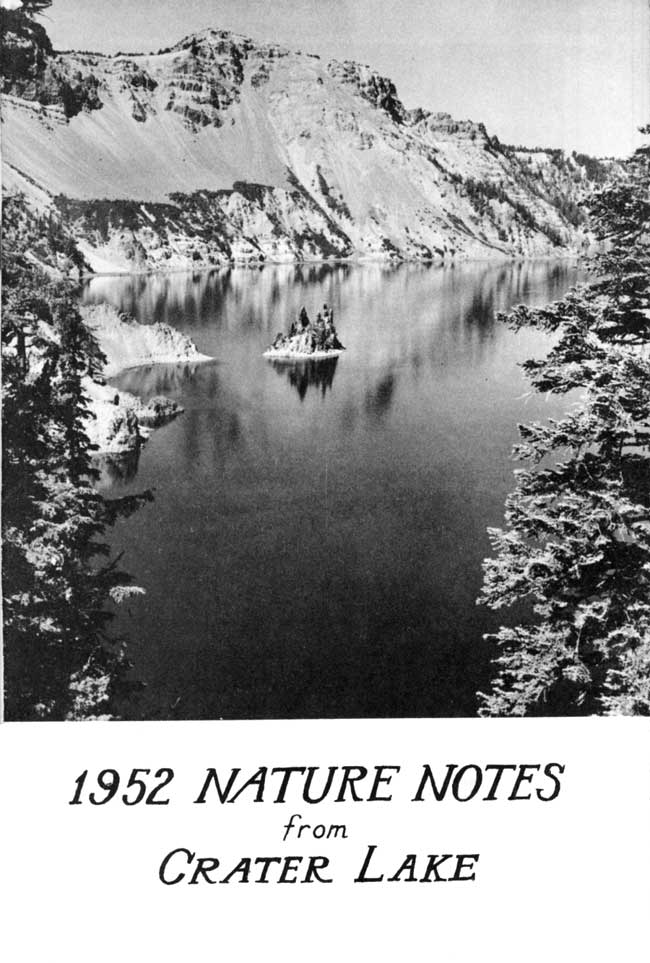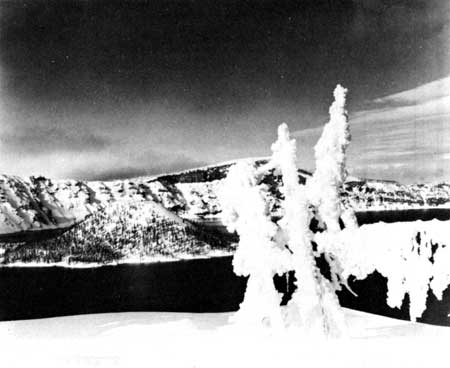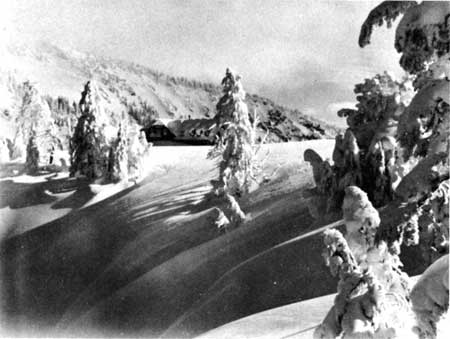Volume 18, page 1, 1952
All material courtesy of the National Park Service.These publications can also be found at http://npshistory.com/
Nature Notes is produced by the National Park Service. © 1952
The Big Snow of 1951-52
The winter of 1951-52 at Crater Lake was preceded by a long dry summer during which there was practically no precipitation after May 13 until the first general fall storms. Most of the residents of the park were anticipating an “easy” winter but by April of 1952 all of us knew we had been through a winter of record breaking snowfall and snow depths.
Weather records have been kept in the park for about 26 years except for the war years and these records show that the average snowfall for Crater Lake is 622.0 inches. This average has been exceeded each year since 1948 and for several winters previously. The record snowfall for the park occurred during the winter of 1932-33 when 879.0 inches of snowfall was recorded between October 1, 1932 and September 30, 1933, which is the weather year for the park.
Snow depths on the ground are in direct proportion to the snowfall so that recorded depths of between 100 inches and 200 inches of snow are common. These greatest depths of snow usually occur during the months of January, February, and March. For example, snow depths for March 1949, 1950, and 1951 were recorded at the Park Headquarters weather station as 171, 180, and 197 inches respectively.
The past winter, however, while not breaking any records for snowfall did result in the greatest recorded depths of snow on the ground since park records have been kept. On March 1, 1952 there was 177 inches of snow on the ground which was only 31 inches from the record. A storm which began on the 3rd and ended on the 8th resulted in 39 inches of snowfall and increased the total depth to 200 inches. It was at this point we realized that if the normal cycle of storms continued, we would break a record. Thereafter, each storm, even though adding to our inconvenience of living and working in heavy snow, was watched with interest and anticipation. Another storm moved in from the southwest on the 9th and continued through the 15th and gave us another 38 inches of snowfall. The depth as recorded reached 201 inches, only 7 inches shy of the record we still hoped would be broken. There still remained 15 days of the month of heaviest snowfall – we should see the record broken.
March 16 was clear and comparatively warm, maximum temperature 37 degrees. Still another storm crossed the Cascades on the 17th and continued through the 20th. This storm carried enough moisture to satisfy our anticipation. In four days 42 inches of snow fell. At the beginning of this four day period the measured depth on the ground was 198 inches. On the second day a total depth of 207 inches was recorded – only one inch shy of the record. Then on the 18th 6 inches of snow fell followed by 10 inches more on the 19th. This was it! At 4:00 P.M. on the 19th the measuring stake recorded 216 inches. The record had been smashed but it continued snowing, and we speculated on how much greater the depth would be. On the morning of March 20, 1952 the measurement reached 224 inches of snow on the ground. During the day, however, the storm moved on and the new snow gradually settled to 218 inches, still a record.
By the end of March there had been measured 798 inches of snowfall, and we now set our sights on the breaking of the record for total snowfall, but this was not to be. The last snowfall on June 14, brought the total to 835 inches, some 44 inches short of a record.
The snowpack for the winter, which is measured periodically to determine water content, was found to be more compact and with more water than for many years previously. Water users in the entire state of Oregon were assured an ample supply for the coming season.
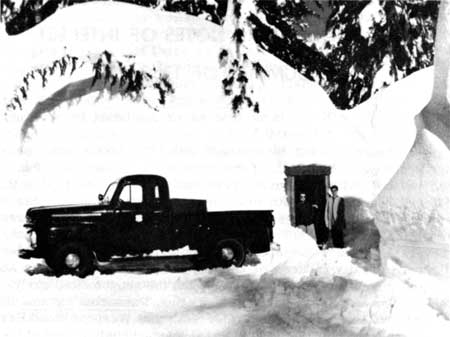
The big snow of 1951-52 as shown by Chief Ranger Hallock’s photographs.
Ornithological Notes of Interest Summer of 1952
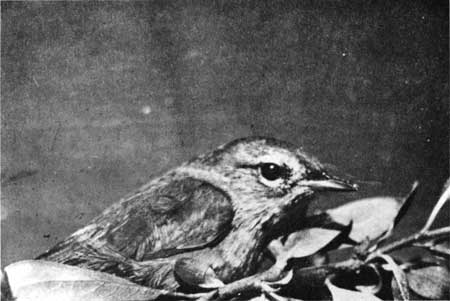
Macgillivray warbler photographed in the headquarters area. From a Kodachrome by Ranger-Naturalist Ralph Welles and Florence Welles.
The summer of 1952, by contrast with 1951, was unusual because of the prolonged persistence of the snow and a consequently much delayed season. Although causal relations must be assumed with the greatest of caution and with much more investigation than has been possible, it is nevertheless interesting to note certain differences between the two seasons.
Several species whose upward altitudinal limits fluctuate substantially were greatly reduced or entirely absent from elevations above 6000 feet in contrast to last summer when the snow melted early. Included in this group are the Lazuli Bunting, Passerina amoena (Say); Fox Sparrow, Passerella iliaca (Merrem); and Western Wood Pewee,Contopus richardsonii (Swainson). Also conspicuously absent at higher elevations were Turkey Vultures, Cathartes aura (Linnaeus).
Perhaps the most spectacular change in the avifauna from last summer was the conspicuous decline in numbers of Red Crossbills, Loxia curvirostra Linnaeus. During the summer of 1952 I saw about 0.9 crossbills per hour in the field compared to 5.5 per hour in 1951. During 1952 they were only in restless flocks whereas in 1951 singing males were observed commonly. Also in 1951 groups feeding in cones or “mineral pecking” could be observed from small distances. Pine Siskins, Spinus pinus (Wilson), however, continue to be common this summer. Huge flocks of several hundred individuals were observed frequently in the Headquarters Area during late July and early August.
It is of interest, to note further, that there was a conspicuous reduction in the numbers of Rosy Finches, Leucosticte tephrocotis (Swainson). This has been particularly noticeable on Dutton Ridge where they were very abundant during the summer of 1951.
There was also a reduction in the density of breeding Lincoln Sparrows, Melospiza lincolnii (Audubon), in the higher montane meadows. The study area in the upper Munson Meadow which I have had under observation for several summers had only two, possibly three, breeding pairs compared to the usual five or six. Although I do not have quantitative data, a similar reduction appears to have occurred in other high-elevation meadows. It seems quite likely that the persistence of the snow in these areas may have been responsible. It should be noted also that there has been a noticeable reduction in the numbers of Dippers, Cinclus mexicanus Swainson, appearing in the upper portions of the streams in mid-summer. Whether this represents a reduction in population or a restrictive effect of the snow on the normal mid-summer migration to higher elevations is not clear.
Despite the fact that there was a severe reduction in the cone crop on the whitebark pine, ponderosa pine, and firs, compared with 1951, there was, during the summer of 1952, a marked increase in Clark’s Nutcrackers, Nucifraga columbiana (Wilson). This is noticeable throughout the high country as well as at the Rim Village, although more pronounced at the latter. It is of interest to note that we saw a considerable number of color-banded individuals which were banded during the summer of 1950 but which failed to reappear during the summer of 1951. The movements of this species continue to be enigmatic! There was also a remarkable increase in the number of Ravens, Corvus corax Linnaeus, observed. At least three small flocks, probably family groups, were observed repeatedly. These were commonly seen in the vicinity of Park Headquarters, Rim Village, and the Watchman, respectively.
Also of interest were the substantially greater recorded numbers of Booming Nighthawks, Chordeiles minor (Forster). Mr. and Mrs. Jack D. Lee reported observing them nightly at Lost Creek in Pinnacle Valley. I confirmed this on three occasions. They were apparently similarly common in the Panhandle. I also observed nighthawks at Arant Point on July 8 and above Castle Creek Canyon (5800 ft.) on August 5.
Several important observations were obtained on swallows. On July 28, I saw three Cliff Swallows, Petrochelidon pyrrhonota (Vieillot), within the Crater wall near Garfield Peak. This is the second record for the Park. On August 2, Ranger-naturalist C. F. Yocom and I saw two Rough-winged Swallows along the Garfield Peak Trail. These are the first records for the Park since 1937 and the first for the Lake area. On July 19 I found a nest of Violet Green Swallows, Tachycineta thalassina (Swainson), in a cavity in one of the Wheeler Creek Pinnacles. This is the first breeding record for the Park.
Despite the heavy snow, the population reproductive activity, and upward migration of Blue Grouse, Dendragapus obscurus (Say), was quite normal.
References
Farner, Donald S. 1951. Ornithological notes of interest. Crater Lake Nature Notes,17:16-18.
Farner, Donald S. 1951. The Red Crossbill irruption of 1951. Crater Lake Nature Notes,17:19.
Farner, Donald S. 1952. The Birds of Crater Lake National Park. University of Kansas Press, ix-200 pp.


